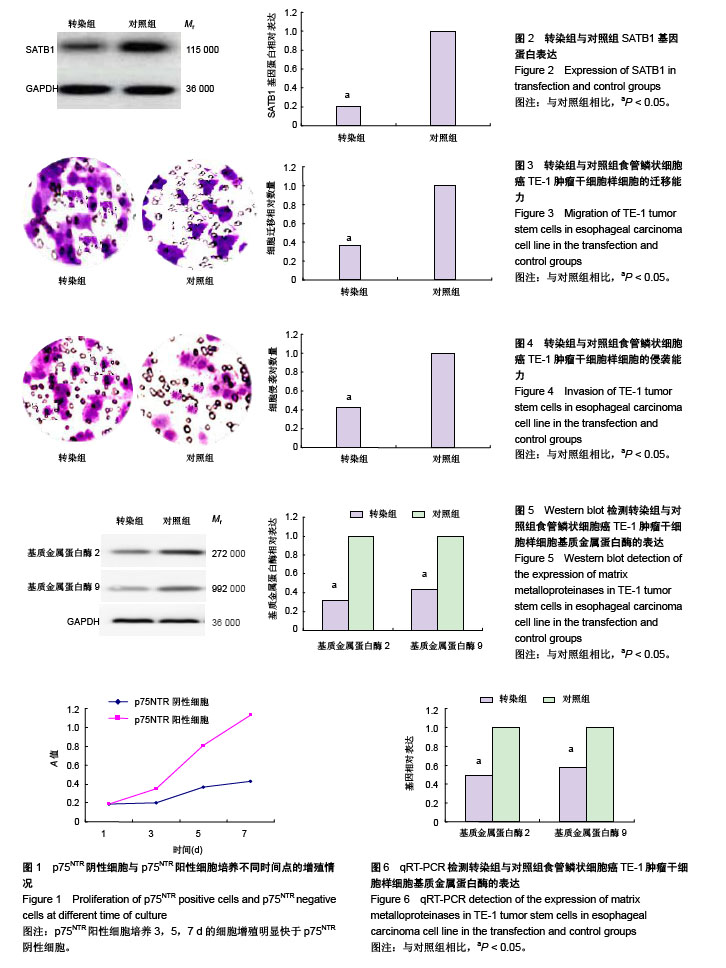中国组织工程研究 ›› 2018, Vol. 22 ›› Issue (17): 2674-2679.doi: 10.3969/j.issn.2095-4344.0529
• 肿瘤干细胞 cancer stem cells • 上一篇 下一篇
SATB1基因沉默抑制食管鳞状细胞癌TE-1中肿瘤干细胞样细胞侵袭及迁移能力
李晓雷1,徐 俊1,胡 欣2,何文武1,郑银彬1
- 南充市中心医院•川北医学院第二临床医学院,1胸外科,2肿瘤科,四川省南充市 637000
Silencing of SATB1 inhibits the invasion and migration of tumor stem cells in TE-1 cell line of esophageal squamous cell carcinoma
Li Xiao-lei1, Xu Jun1, Hu Xin2, He Wen-wu1, Zheng Yin-bin1
- 1Department of Thoracic Surgery, 2Department of Oncology, Nanchong Central Hospital, Nanchong 637000, Sichuan Province, China
摘要:
文章快速阅读:
.jpg)
文题释义: SATB1:是一种组织特异性的核基质结合蛋白,高表达于胸腺细胞,参与组织特异性基因的表达调控,在染色体构建、免疫调节、肿瘤发展转移和细胞凋亡方面有重要作用。目前在乳腺癌、肝癌、结直肠癌、膀胱癌、肾透明细胞癌及卵巢黏液腺癌等肿瘤组织中检测到SATB1高表达。 RNA干扰技术:是将外源性或内源性双链RNA导入生物体细胞中,抑制相应基因表达的一种技术。目前的RNA干扰技术主要是将外源性的siRNA基因引入生物体细胞,介导基因沉默。
摘要
背景:近来有研究证实SATB1与肿瘤的发生及发展有关,但其在肿瘤转移中的机制尚不明确。
目的:观察特异性干扰SATB1基因表达对食管鳞状细胞癌TE-1中肿瘤干细胞样细胞侵袭、迁移的影响。
方法:采用免疫磁珠分选法从人食管鳞状细胞癌TE-1中分选p75NTR阳性细胞与p75NTR阴性细胞,检测p75NTR阳性细胞的体外增殖能力及克隆形成能力。取对数生长期的p75NTR阳性肿瘤干细胞样细胞,转染组利用Lipofectamine 2000脂质体法将SATB1基因siRNA转染至细胞中,同时设置空载体转染的p75NTR阳性细胞为对照,转染后72 h,采用Western blot法检测2组细胞SATB1蛋白表达,Transwell小室实验检测2组细胞的迁移及侵袭能力,Western blot与qRT-PCR法检测基质金属蛋白酶2/9的表达。
结果与结论:①与p75NTR阴性细胞比较,p75NTR阳性细胞培养3,5,7 d的细胞增殖明显加快(P < 0.05);②p75NTR阳性细胞的克隆形成率明显高于p75NTR阴性细胞(P < 0.05);③转染后72 h后,转染组SATB1基因蛋白表达明显低于对照组(P < 0.05),迁移能力与侵袭能力明显低于对照组(P < 0.05),基质金属蛋白酶2/9的基因及蛋白表达明显低于对照组(P < 0.05);④结果提示,以siRNA干扰SATB1基因后,可抑制食管鳞状细胞癌TE-1肿瘤干细胞样细胞侵袭、迁移,可能与其下调基质金属蛋白酶2/9的表达有关。
中国组织工程研究杂志出版内容重点:干细胞;骨髓干细胞;造血干细胞;脂肪干细胞;肿瘤干细胞;胚胎干细胞;脐带脐血干细胞;干细胞诱导;干细胞分化;组织工程
ORCID: 0000-0001-7049-7882(李晓雷)
中图分类号:

.jpg)